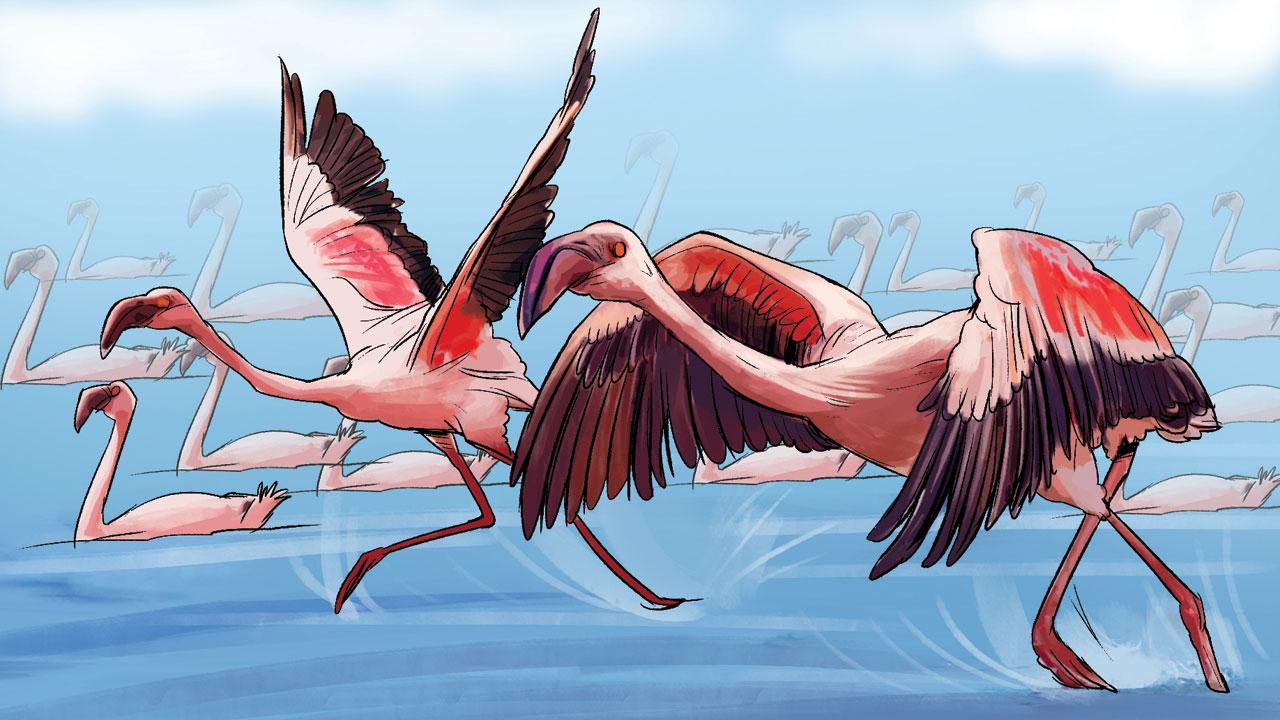How had it appeared, 5,000 miles away, being too small to fly that far? Answer: It had taken a boat.

Illustration/Uday Mohite
![]() This year a record number of flamingos flew into Bombay—1,33,000. Apparently one reason for these swelling numbers is believe it or not, pollution. The pollution at Thane Creek is conducive to the growth of microorganisms that flamingos feed on. But it’s also pollution and “development” in other places, which is causing wetlands to shrink, that is making our city a place where more birds gather.
This year a record number of flamingos flew into Bombay—1,33,000. Apparently one reason for these swelling numbers is believe it or not, pollution. The pollution at Thane Creek is conducive to the growth of microorganisms that flamingos feed on. But it’s also pollution and “development” in other places, which is causing wetlands to shrink, that is making our city a place where more birds gather.
The thought of these birds flying in from nearby Gujarat, but also far away Afghanistan, Iran and parts of Africa, feels magical and mythical. The return of the golden orioles with autumn is simultaneously wondrous and comforting, like an embrace from nature. The shooting through of flowers, red, purple, pink, mulmul white, as the sun grows hotter, quickens our blood too. In the lockdown, some people were prone to exclaim “nature is coming back” as though nature were a static being, when in fact all of nature is always coming and going, here and there, by chance or need or design, migrating willingly or unwillingly, as do humans.
Some time ago, it was reported that a little bird caused big excitement among birders on an island near Cornwall, England. This bird, a Blackburnian warbler, with a flaming orange throat and a high-pitched, trilling song is native to North American pine forests. How had it appeared, 5,000 miles away, being too small to fly that far? Answer: It had taken a boat.
For some years now, ornithologists have been observing that many migratory birds, especially in the Mediterranean, hitch a ride on ships and boats, as they fly across the seas. They do it when they are depleted, or the weather is bad. Earlier they stopped on islands, but ships are more plentiful than islands, so they use those instead now. In doing so they create a kind of science poetry rhyme: birds’ bodies are boat-shaped, enabling them to sail through the air—or perhaps boat-bodies are bird-shaped so they can sail through the water. In 1994, two Indian crows stowed away on a ship and arrived in the Netherlands where they have now established a colony in a place called Hoek von Holland. There are several concerned papers on the internet that describe this as “invasion” and “colonisation”, featuring harassment of local avifauna and fouling of human settlements and calling for EU level interventions.
A kind of historical rhyme, with reason. One of the most haunting videos I encountered on the internet is from 1987. It is a record of the last Kaua‘i‘ō‘ō bird in the world, singing out a mating call to a female bird that will never come. It sounded as lonesome as a human. It went extinct soon after. I wonder about that lone Blackburnian warbler then—a kind of reverse version, arriving in a new world, as adventurers do. Alone can mean such different things.
Homes, like intimacies, can be many, everywhere at once and not only for those with OCI cards. The birds remind us that belonging is not simply about passports, but about lands we live in, our ability to welcome guests into it with apnapan and joy, like the blooming pink flamingos in our creeks, creating many new kinships. What is home but a place we feel free to come and go to as we need?
Paromita Vohra is an award-winning Mumbai-based filmmaker, writer and curator working with fiction and non-fiction. Reach her at paromita.vohra@mid-day.com
 Subscribe today by clicking the link and stay updated with the latest news!" Click here!
Subscribe today by clicking the link and stay updated with the latest news!" Click here!










